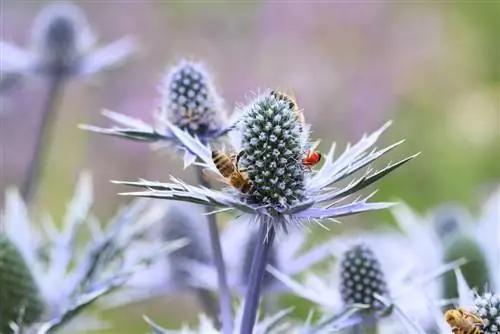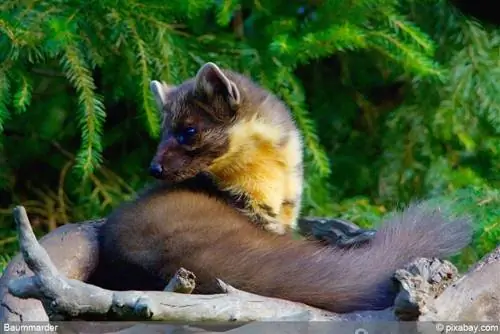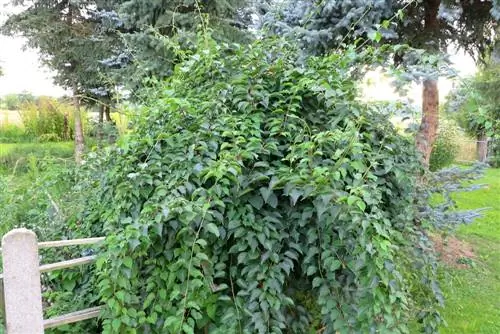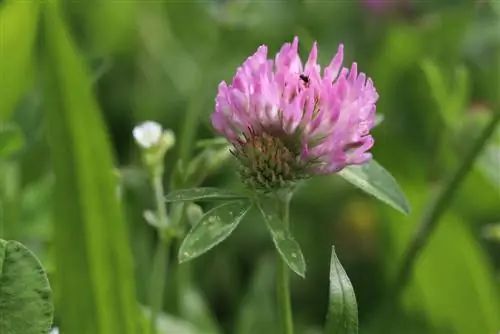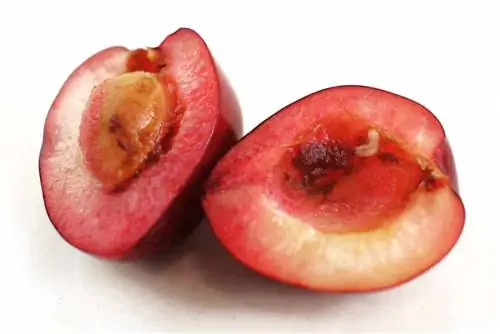- Author admin [email protected].
- Public 2023-12-17 03:39.
- Last modified 2025-06-01 06:48.
Many plants with thorns are called “thistle” when they don’t look anything like a rose. You might come across ivory thistles, donkey thistles, safflowers, goose thistles, gold thistles, thistles, globe thistles, milk thistles, milk thistles, ring thistles, ecologically valuable and useful plants, only the field thistle should be tackled as quickly as possible:
Weak thistles, strong thistles
Of all the “German thistles”, only the field thistle is really annoying, as it drives its roots up to 2.8 m deep into the earth and then also sends out root sprouts from the horizontally growing runner roots that are deep in the ground. They can spread widely; if sections remain in the ground when you dig them up, they will become new plants; Cleaning up a long-grown field thistle area is really no fun anymore. The remaining thistles also include (fewer) runner-forming species, such as the field sow thistle. When removing such spreading thistles, you can be prepared for more or less intensive endurance work, and you can also do a lot with your garden soil to ensure that thistles stay away (more on all of this below).
How to recognize the thistle, which should be de alt with immediately:
- It grows persistently and reaches heights of between 30 and 150 centimeters
- The quite thick stem usually branches extensively
- It is green to reddish, more or less spiny, hollow and contains a bitter milky juice
- As soon as it appears, the thistle only forms a rosette directly on the ground
- Some of these show bays and are covered with thorns on the edge
- These thorns are soft to rigid and pointed, they are about 5 mm long
- The top of the leaf itself is smooth
- The flowering period is between July and October
- The flower is a kind of conical, spiky nub about 2 cm in diameter, from which many thread-like individual flowers emerge from the top
- Light purple to pinkish red in color, until unfolding in deeper tones, said to smell of honey
- About four weeks after flowering begins, a pappus (seed puff, like a dandelion) forms, which is ripe from August to October
- The individual umbrellas with the seeds can fly over 10 km when there is an updraft
- But the seeds should only germinate in very suitable locations
- Thistles like to grow in bushes and hedges in dry, sunny places
- Unfortunately not everyone sticks to it, you can occasionally find them in moist, partially shaded locations
- They are only very rarely found at altitudes above 2000 meters (but also in gardens)
- Growth height, leaves and size of the flower heads can look quite different
- It is not the identification of a possible subspecies that is important to you, but rather how the thistle spreads
- And the field thistle is one of the propagation artists
- If you dig them up, you will find horizontal, creeping root shoots quite deep in the ground
Many native thistles only grow as one or two years, so you could simply look forward to the end of the individual plant with peace of mind. They spread through their seeds, which can fly for miles (as is often warned, but that's a good thing, because if the seeds of "your" thistles fly for miles, they will fly out of your garden). You can keep these thistles under control by preventing them from seeding, the best way to do this is described below.
How do thistles get into the garden?
Thistles are old native plants and are probably among the first “pioneer” plants in our soil. The undemanding plants can even colonize soils on which plants with normal needs can hardly grow, and the fact that root pioneers like the field thistle have now spread so much that they are already feared has to do with our treatment of the nature around us: Today, a lot is happening in soil management that no longer has anything to do with the rules of a farming/horticultural culture that have developed over many years of experience. Crop rotation is “out”, plants with weak competition are planted one after the other, and there is not enough varied planting to help the soil recover. Soil cultivation, especially in gardens, is carried out minimally or improperly (bare soil). Thistle growth in agriculture is not regulated by natural means, but by chemicals. Since hardly any grazing livestock is kept anymore, hardly any thistle-controlling livestock feed such as grass clover is grown.
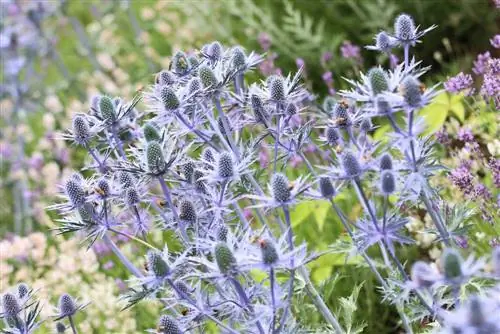
Root-cutting tillage implements (disc harrows, rotary harrows, tillers) are displacing plows that turn the soil. Fallow land (including topsoil cleared for construction work) is left bare and fallow to its own devices instead of being cared for with suitable planting. Thistles like to colonize patchy/weak plant populations that are the result of pest or disease infestation on pesticide-infused monocultures and are allowed to seed there unhindered. Pesticides are often used too early/incorrectly (especially in private gardens), which also promotes the spread and development of strong plants such as thistles.
This means that thistle reproductive organs (seeds or root residues) are increasingly in the air and soil around us; they could have been slumbering in soil that was newly added to a new building plot, waiting under or in the turf for their appearance, or simply flown in from neighbors. If the question of its origin has been clarified with a certain degree of probability, the thistle is not gone yet. A thistle that flies in from the nearest field/garden that doesn't necessarily have particularly plant-friendly soil or from an unkempt wasteland will spread to you even if your soil is not in good condition. But if the thistle finds beautiful, nutrient-rich, deep and loamy garden soil with sufficient water supply, it will find it even better. Before considering a soil or garden management that makes it difficult for thistles to establish themselves, the currently existing thistles must be removed, quickly and consistently:
Removing thistles - the best remedies
If you want to get rid of thistles, there are a few different effective options for the garden and lawn:
1. Removing thistles from the lawn
You can cut out very small, young thistles with a weed cutter. You should then scrape a little along the walls of the hole with the digger to check whether you have got all the roots, if necessary, dig a little further and remove pieces of the roots. Larger aggressive field thistles etc. The best way to get rid of them on the lawn is to keep mowing them down (frequent mowing is also good for the lawn). As soon as possible before rain is forecast (or water the lawn after mowing), thistles will rot if water gets into the hollow stems that were cut off during mowing. But there are thistles that grow so flat that they can no longer be caught by the mower blade. Because of them, you don't need to peel the lawn down to ground level, it doesn't like that at all. Rather, you should wait for friendly (10 to 25 °C) and moist growing weather and at the beginning of this only cut/cut out the thistles on the very surface so that the roots remain in the ground. Then fertilize the lawn, wait until the thistles, stimulated by half-hearted pruning, sprout like crazy - and then mow them down. If the lawn receives such care two or three times in a row, the thistles should be finished, but the lawn should look very good. If a thistle appears again afterwards, you should cut it out so young that you get all the roots. If it is already too late for that, the treatment just described starts again.
2. Remove thistles from the garden soil
When thistles appear in other places in the garden, they are plucked out young, with a long weed cutter and completely. Older specimens are dug up, dug up in such a way that the last remaining roots are removed from the garden soil. If a heavy thistle weed infestation has been allowed to develop on your property, you will probably need to do this again every few days during the peak growing season, and again once a week later in the year. Numerous thistle sprouts have already been planted from the horizontal and deep-growing main root. They will gradually come to the surface and must be removed immediately if the spit is to stop. If there is no time for labor-intensive digging down to the last remnant of roots, you can cut away the entire upper plant mass of the thistle as an emergency measure. However, if possible, you should only do this when the thistle is already blooming and is very close to the seeds ripening. Then you can prevent the thistle from seeding without it reacting by increasing its spread via the roots. If you cut thistles away earlier, it amounts to the repeated mowing (in the bed: cutting away) recommended above, because thistles that are prevented from forming seeds early in the growing season try to compensate for this with stronger (root) growth and therefore have to be constantly weakened again.
Beware of unsafe thistle removal tips
You think the tips for thistle removal are too meager, surely there are more ways to destroy prickly plants? Of course, there are even articles with 10 or 12 tips for destroying thistles, but that doesn't mean that the tips from 5 onwards make a lot of sense. In fact, a number of things are recommended to combat thistles, which you should only implement with great caution:
- Pulling out by hand is the most effective method
- Undoubtedly - but only if you want a garden full of thistles
- If you tear off the root when pulling it out (very likely), new thistles will sprout
- With thistles with horizontal root runners in full panic from every corner of the garden
- Vinegar against thistles is recommended and has actually been tested against field thistles, but is still a banned pesticide
- S alt against thistles probably helps, but releasing it into the environment is often a criminal offense
- The fungus Puccinia punctiformis causes the death of field thistles and could probably be obtained from abroad
- Its use and transmission mechanism (weevil) is also currently being researched; until results are available, its application would be criminally reckless
- Use of pesticides is recommended, but they also harm other plants
- Probably faster than the robust thistles, otherwise the thistles would have already been limited by competition
- The quality of the garden soil is not necessarily changed in a positive way either, and pesticides are increasingly being criticized for he alth reasons
Prevention
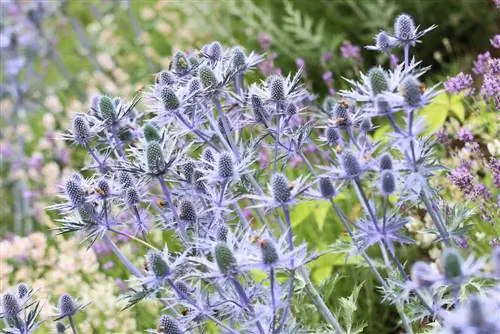
What you can do to ensure that the thistles do not come back immediately depends on the condition of your garden soil: A good soil should be more versatile and planted with strong (native) plants that have long been adapted to the location Thistles face strong competition. Fallow ground should be enriched with sand if it is very moist; thistles are less common on light, dry sites. It should also be equipped with transitional planting. Poor soil should be transformed into good soil through soil rehabilitation (with green manure), then see above. If you are unlucky, new thistles will still fly in; thistle seeds can be carried very far by the wind. Maybe you can just let the thistles grow, there is not only the evil field thistle - which should really be combated - but also beautiful and useful thistles, in ecological, culinary or other respects:
- Ivory thistles, ass thistles and globe thistles are valued as decorative ornamental plants
- The flowers of the only native safflower Carthamus tinctorius replace the valuable saffron as safflower, the seeds produce safflower oil, it can be used as a dye plant
- There are goose thistles, thistles, gold thistles, whose leaves, cooked flower base and roots are said to taste delicious
- Gold thistles, silver thistles and milk thistles are grown as medicinal plants
- Most thistles, including the field thistle, feed insects of all kinds, especially butterflies and wild bees
- All thistles are important food plants for grain-eating birds such as finches, sparrows, reed buntings and provide food even late in the year
Conclusion
If your garden is overgrown with thistles, it is annoying and sometimes requires some work. Sometimes they are also useful thistles that you just need to sort out a little and maybe even use.

